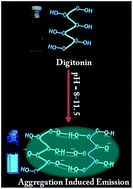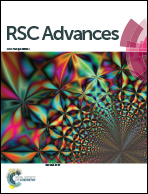Hydrogen-bond assisted, aggregation-induced emission of digitonin†
Abstract
Contrary to the conventional aggregation-induced emission (AIE) luminogens obtained from the addition of poor solvents to the solution of organic molecules in good solvents, we serendipitously observed the AIE phenomenon arising from the addition of a strong base to the aqueous solution of the aliphatic glycoside molecule digitonin. Detailed spectroscopic and microscopic studies were carried out to unearth the mechanism of this transformation from weakly luminescent form to highly luminescent blue AIEgen. They reveal that the formation of strong inter- and intramolecular hydrogen bonds between the partially deprotonated forms of digitonin, which restricts the molecular rotation, is the main cause of fluorescence enhancement in base-treated digitonin. Quantum yield of the base-treated digitonin is found to be 0.135 with 93% enhancement compared to the parent molecule. Further, photoluminescence intensity of the base-treated digitonin can be tuned by changing the pH from 7–14. We have also shown that the blue-green luminescent base-treated digitonin can effectively transfer excited-state energy to Rhodamine B, which results in white light emission from the digitonin–Rhodamine mixture.


 Please wait while we load your content...
Please wait while we load your content...